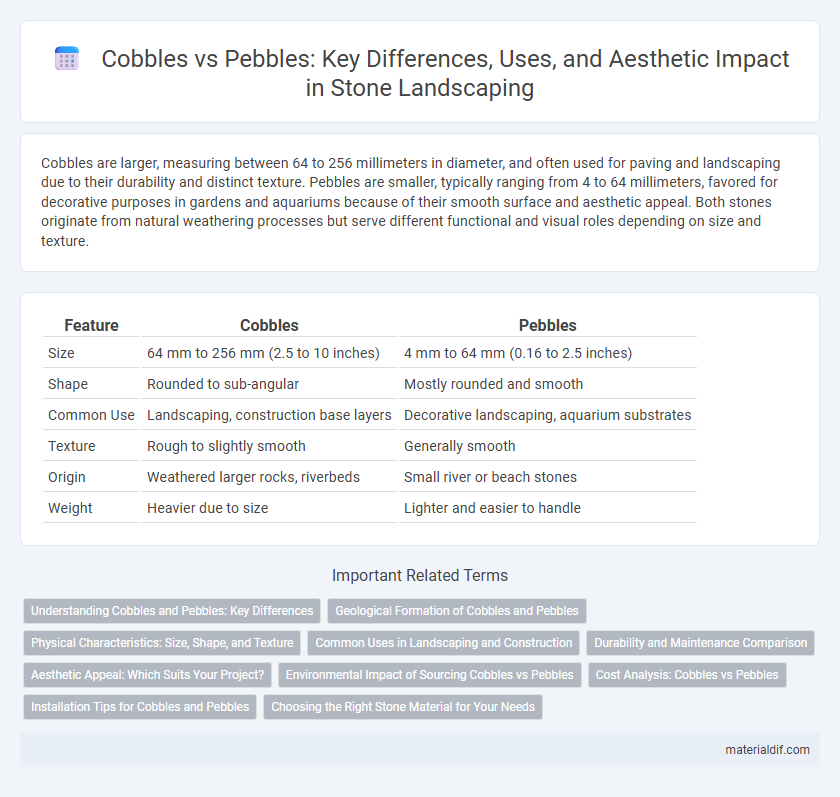Cobbles are larger, measuring between 64 to 256 millimeters in diameter, and often used for paving and landscaping due to their durability and distinct texture. Pebbles are smaller, typically ranging from 4 to 64 millimeters, favored for decorative purposes in gardens and aquariums because of their smooth surface and aesthetic appeal. Both stones originate from natural weathering processes but serve different functional and visual roles depending on size and texture.
Table of Comparison
| Feature | Cobbles | Pebbles |
|---|---|---|
| Size | 64 mm to 256 mm (2.5 to 10 inches) | 4 mm to 64 mm (0.16 to 2.5 inches) |
| Shape | Rounded to sub-angular | Mostly rounded and smooth |
| Common Use | Landscaping, construction base layers | Decorative landscaping, aquarium substrates |
| Texture | Rough to slightly smooth | Generally smooth |
| Origin | Weathered larger rocks, riverbeds | Small river or beach stones |
| Weight | Heavier due to size | Lighter and easier to handle |
Understanding Cobbles and Pebbles: Key Differences
Cobbles range in size from 64 to 256 millimeters, making them larger and more angular compared to pebbles, which measure between 4 to 64 millimeters and tend to be smoother due to water erosion. The distinct size and texture differences affect their uses in construction, landscaping, and drainage systems, where cobbles provide structural stability and pebbles offer aesthetic appeal. Recognizing these key differences helps in selecting the right material for specific projects, ensuring both functionality and design effectiveness.
Geological Formation of Cobbles and Pebbles
Cobbles and pebbles are classified based on their size within the sedimentary grain scale, with cobbles ranging from 64 to 256 millimeters and pebbles from 4 to 64 millimeters. Both form through the mechanical weathering and erosion of larger rocks, transported and rounded by water, wind, or glacial activity over time. Geological formations of cobbles are typically found in high-energy environments like riverbeds and glacial deposits, whereas pebbles are more common in calmer settings such as beaches and streambeds.
Physical Characteristics: Size, Shape, and Texture
Cobbles are larger and typically range between 64 and 256 millimeters in diameter, while pebbles are smaller, measuring between 4 and 64 millimeters. Cobbles often have a more angular and irregular shape, whereas pebbles tend to be smoother and rounder due to prolonged weathering and water transport. The texture of cobbles is generally coarser with rough surfaces, contrasting with the finer, polished texture commonly found on pebbles.
Common Uses in Landscaping and Construction
Cobbles, measuring between 2.5 to 10 inches in diameter, are commonly used for durable pathways, decorative borders, and retaining walls due to their robust size and stability. Pebbles, smaller and typically under 2.5 inches, are favored for ground cover, garden beds, and water features because of their smooth texture and aesthetic appeal. Both materials enhance landscaping designs, but cobbles provide structural support, while pebbles offer decorative versatility.
Durability and Maintenance Comparison
Cobbles exhibit higher durability due to their larger size and dense composition, making them resistant to heavy wear and weather conditions. Pebbles, while aesthetically pleasing and easier to handle, require more frequent upkeep to prevent displacement and surface erosion. Maintenance for cobbles involves occasional cleaning and sealing, whereas pebbles often need replenishment and stabilization to maintain their appearance and integrity.
Aesthetic Appeal: Which Suits Your Project?
Cobbles offer a rugged, natural look with varied sizes and irregular shapes, perfect for creating rustic pathways and garden borders that evoke timeless charm. Pebbles provide a smoother, more uniform appearance, ideal for modern landscaping projects, water features, and decorative accents seeking a polished aesthetic. Choosing between cobbles and pebbles depends on the desired visual impact, texture, and overall design style of your outdoor space.
Environmental Impact of Sourcing Cobbles vs Pebbles
The environmental impact of sourcing cobbles versus pebbles varies significantly due to their size and extraction methods; cobbles, being larger, often require more intensive quarrying or riverbed disruption, leading to greater habitat disturbance and increased carbon emissions from heavy machinery. Pebbles, smaller and more abundant, are typically gathered from riverbeds or beaches with less invasive techniques, resulting in lower environmental degradation and minimal disruption to ecosystems. Sustainable sourcing practices and regulatory compliance are crucial in minimizing the ecological footprint of both cobble and pebble extraction.
Cost Analysis: Cobbles vs Pebbles
Cobblestones typically incur higher installation costs due to their larger size and the need for more precise placement compared to pebbles, which are smaller and easier to install. Pebbles offer a more budget-friendly option, especially for larger surface areas, as they require less labor-intensive groundwork and can be spread quickly. However, cobbles offer greater durability and aesthetic appeal, often justifying the initial expense in long-term value.
Installation Tips for Cobbles and Pebbles
Cobbles require a stable, well-compacted base to prevent shifting and ensure long-term durability, making crushed stone or gravel ideal for the foundation. Pebbles benefit from being embedded in sand or fine mortar to maintain their position while allowing for natural drainage. Both materials demand regular maintenance to keep joints clean and prevent weed growth, enhancing their aesthetic appeal and structural integrity.
Choosing the Right Stone Material for Your Needs
Cobbles and pebbles differ primarily in size and texture, affecting their suitability for various landscaping and construction purposes. Cobbles, larger and more angular, provide durability and stability for pathways and driveways, while pebbles, smaller and smoother, are ideal for decorative gardens and water features. Selecting the right stone material depends on the specific application, desired aesthetic, and functional requirements such as drainage and maintenance.
Cobbles vs Pebbles Infographic

 materialdif.com
materialdif.com